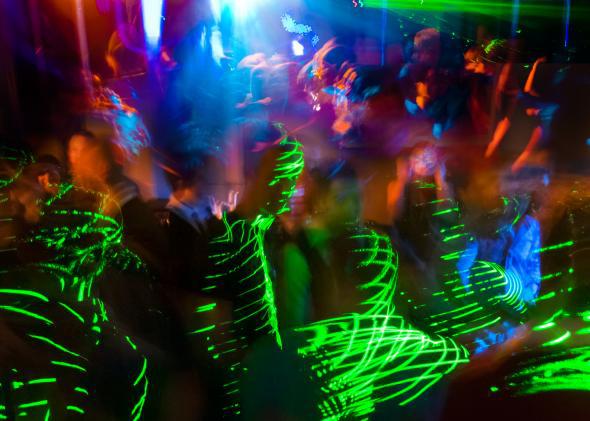In 1978, at a time when gay men were still widely stigmatized as deviant perverts, Andrew Holleran published an extraordinary novel called Dancer from the Dance. Holleran managed to balance sorrow with celebration, producing something that seems to both foreshadow the AIDS crisis and find nobility in an orgiastic lifestyle that was being lived in society’s shadows. The book is giddy and doleful, earnest and arch—a drag queen of a novel. (Sutherland, a central character, argues at one point that a person can only depend on concrete things in life, “like cock.” Then he ashes a cigar in a bowl of faded marigolds.)
Sitting at the thematic heart of Dancer from the Dance is, unsurprisingly, dance. The book weaves in and out of extinct New York clubs (with multiple forays to Fire Island), and dance assumes a powerful symbolism in the process. “The friend you danced with, when you had no lover, was the most important person in your life,” claims the narrator. “For people who went without lovers for years, that was all they had.” Dance is a communion with like-minded people, an act of solidarity, intimacy, and defiance. Sutherland calls it “the only antidote to death we have.” This is the most compelling and persuasive rationale for the importance of dance in gay culture—for gay nightlife in general—that I have ever read.
I offer this literary aside in response to two pieces of news this week: The first, an op-ed by nightlife impresarios Justin Luke and John Blair entitled “Gay Nightlife Is Dead – Long Live Gay Nightlife,” published in The Advocate; and the second in the New York neighborhood of Washington Heights, where a gay bar named No Parking announced it will close to make way for a Planet Fitness. Taken together, the stories show that the ills of gay nightlife depend on who’s doing the diagnosing.
Luke and Blair’s commentary attempts to rebut the “recent avalanche of articles mourning the death of gay nightlife” in New York. I must admit to having already donned the black veil on that count myself, so I was surprised to read that gay nightlife is apparently thriving in the city. Really? To support this argument, our informants offer an evocative description of “almost 2000 guys” dancing ecstatically, arms in the air, at VIVA, a club in the Hell’s Kitchen enclave. “From where I’m standing, gay nightlife is doing just as well as it ever did,” they write together.
This is a rather fantastic claim. Forget the fact that the casualty list—The Roxy, Tunnel, Twilo, Limelight, Urge—is already too long. With the addition of No Parking, a gay bar for black and Latino men, by way of gentrification this week, The Advocate defense rang as utterly tone-deaf and worse, culturally biased.
It’s important to acknowledge that Luke and Blair are, first and foremost, savvy party promoters. John Blair presents dances at VIVA and has been a mainstay on the nightlife circuit for years. Justin Luke co-owns BoiParty, a promotions company that runs “three of the largest weekly gay dance parties for hot gay guys.” Nobody wants to trumpet the death of their own industry, so of course they are optimists.
I value gay nightlife, too, and I want it to thrive. I take pleasure in those shirtless all-night dance parties. But I also think that Luke and Blair’s argument embodies an alarming and widespread narrow-mindedness that mistakes one group’s situation for the reality of everyone. “Some say that gay party scene is dying out, but others say it’s just evolving to meet the needs of its audience,” explains the article’s lead. But whose needs, exactly? My guess: The vocal, powerful, upwardly mobile, white, gay male mainstream. The irrefutable truth of things is that gay nightlife for LGBTQ minorities really is dying out.
Anybody who ever had the pleasure of visiting No Parking will admit that the place is––was––completely filthy, with an unsettling odor and strippers who didn’t seem to consider bodily maintenance particularly important. Many of my friends who live in Chelsea or Hell’s Kitchen made the journey up to 176th Street exactly once, and declared it “awful.” They were wrong, though. No Parking was great. It was also vital. Like Chi-Chiz on Christopher Street (closed) and the Starlite Lounge in Brooklyn (also closed), it offered public space to a queer group that, for a variety of reasons, continues to lag in the push for equality and visibility. I rarely see these people in pricier, sleeker establishments downtown, where they are often made to feel unwelcome either directly (by the bouncer demanding multiple forms of I.D.), or indirectly (by judgmental hostility, which I’ve witnessed firsthand). If dancing and nightlife is, as Holleran suggests, about solidarity and strength in the face of marginalization, then it’s a sad irony that the people who need those spaces to dance the most are the very ones that are losing them. That the gay community might also be encouraging marginalization within its own ranks is a disgrace.
“New York nightlife isn’t dead – it’s just changed,” write Luke and Blair. “And many of those who claim it is dead simply didn’t change with it. I’d like to set the record straight for you. Then I’d like to invite you out to VIVA to see for yourself.”
Luke and Blair mean well, but this is both a risible assertion and a false invitation. To minorities in the queer community who have relied on their own now-shuttered bars, like No Parking, change has rarely been particularly inclusive or equitable. It is not that they “simply didn’t change with it”––they haven’t had the same opportunities. But maybe they really should take up Luke and Blair’s offer, flock to VIVA, demand entry, fill up the dancefloor, and dance. Now that would be a change worth seeing.
